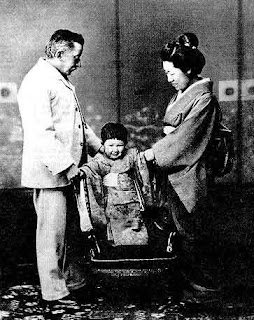The images of the Japanese calamity are overwhelming not only by revealing the vast physical damage but also by reminding us once again that humans are mere toys in the hands of mother nature. ‘Like toys’ was the often repeated phrase on people’s lips, here in Kyoto and probably elsewhere, as we watched cars, ships, houses being tossed about like children crash theirs in anger or boredom. The tectonic plates were either bored or very angry indeed on March 11th. People spared by the wrathful tremors stood silently in awe and disbelief. On television, it was as if we were watching a high-budget disaster movie from the comfort of our armchairs, largely unable to find a suitably emotive response (the reminiscences of 9/11: as one of the Twin Towers has just collapsed a woman is screaming, ‘What the hell is going on!!’).
I was glued to the screen for the first couple of days but once my ahs and oh my gods started to sound less personal and more like united voices of democratic concern, I decided enough was enough. Not quite ‘mad as hell’, but I sure couldn’t take it any more: the horrifying headlines, the nuclear explosions, the misery in the north, the scares, the confusing charts, the mixed messages, the cautious experts versus the alarming voices of the news anchors. I was weary. So on the third day I ventured out to meet a friend. I didn’t care any more that the Fukushima plant was very much touch-and-go as yet another explosion was lurking round the corner. Jerry and I decided to go to the riverside, of all safe places. The Yodogawa riverbank was a perfect antidote to the claustrophobic environs of the past days. We brought out guitars, alcohol, poems and spent that afternoon jamming, drinking, chewing the fat. Maybe we chose to be there so that if someone asked us years later, ‘Where were you when the reactor 2 blew up?’ we’d say, ‘At the riverside, drinking booze’.
Watching other people’s misery on the television for hours on end gave me a consoling, if largely false, notion that I was being compassionate and concerned (if one wants to show compassion one should donate money to charity). On the other hand, my running away to the riverside despite the potential danger to my well-being, however infinitesimal, was a potentially self-destructive act, verging on nihilism. Yet it made a perfect sense to me. Our perception is at the same time an evaluation, and every evaluation, being subjective, results in a choice, be it moral or immoral (what is ethical over here may be less so over there). What would your average ‘neo-nihilist’ have to say about this? Let’s look at what a certain philosophy student wrote on ‘Philosophy Forums’:
It is logically impossible to derive an "ought" prescription from an "is" description or a value from a fact. For example it may be a fact that we have evolved compassion to aid our survival. But from this fact it is impossible to derive the value that one "ought" to be compassionate. Such a transgression of logic is as invalid as deriving the value that one "ought" to be aggressive from the fact that we have evolved aggression. Morality then is not based on reason but on sentiment which is both biologically and culturally conditioned. As Hume stated : "It is not contrary to reason to prefer the destruction of the whole world to the scratching of my finger." (It is not contrary to reason, it is just highly unusual).
[…] We perceive what is of value to us. Nihilism per se is impossible due to human nature. But different things are valuable to different people and different creatures. Therefore this account is known as neo nihilism. Objective morality is an illusion and like religion is a means to control others.
[…] To criticize is only to establish that a concept vanishes when it is thrust into a new milieu, losing some of its components, or acquiring others that transform it. But those who criticize without creating, those who are content to defend the vanished concept without being able to give it the forces it needs to return to life, are the plague of philosophy... Philosophy has a horror of discussions. It always has something else to do.http://forums.philosophyforums.com/threads/metaethics-neo-nihilism-37641.html
To revert to the common suffering. In case you haven’t had enough of tsunami pictures, here is my pick of some of the most enduring ones. In the case of large-scale catastrophes, the aerial shots, the mid shots and the close-ups are all equally effective: buildings on fire, people being rescued or not rescued, people stuck in traffic, people tucked in street corners for the night, a man pondering a remoulded landscape, the elderly staring nowhere in particular. And then, the toys.
You can download hundreds of similar images in a large zip file (235 MB) here (if you can get past the uploader’s idiotic comment).















